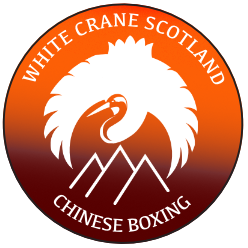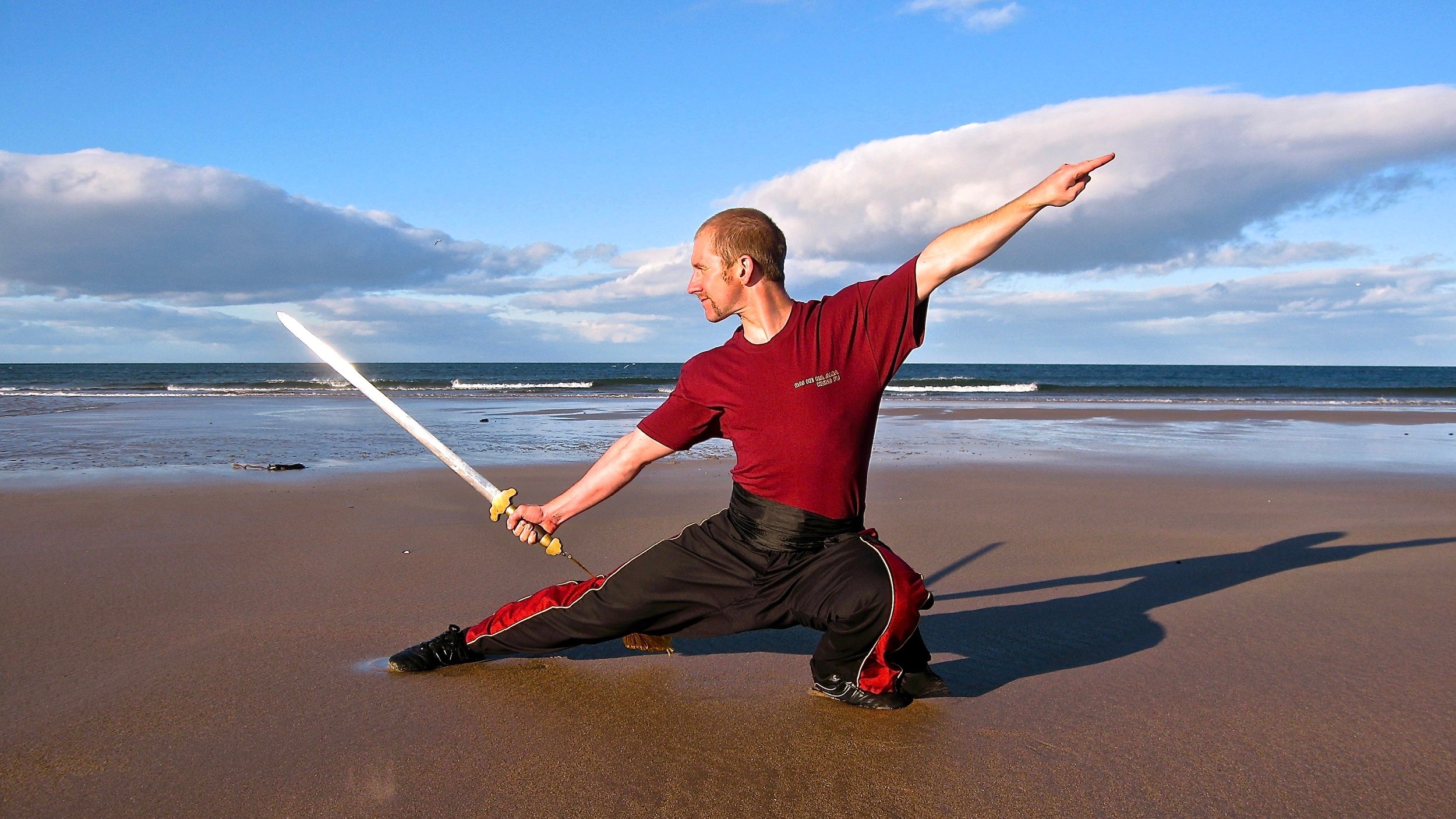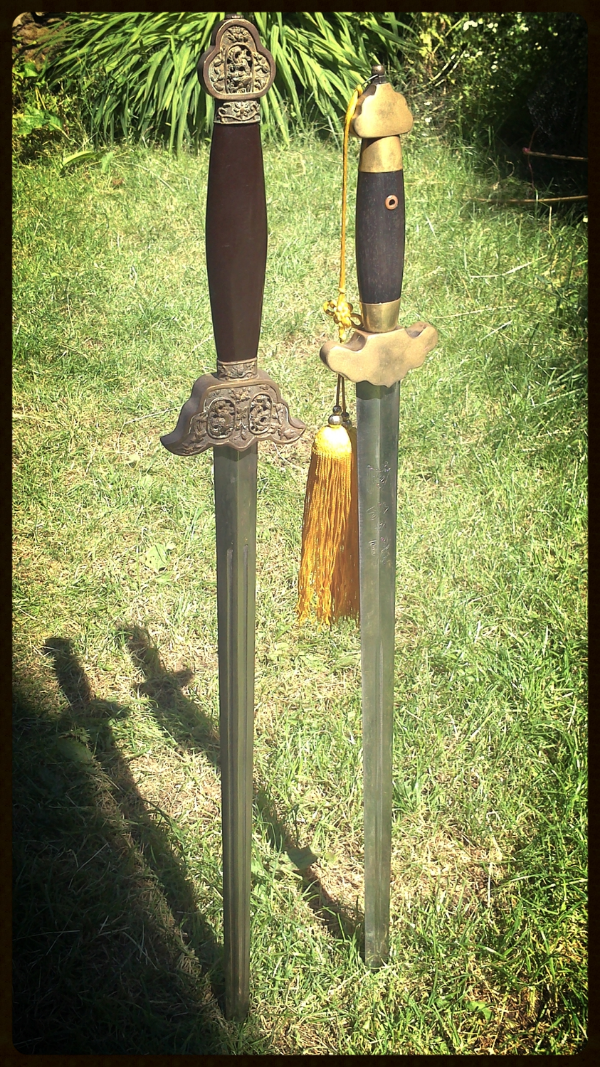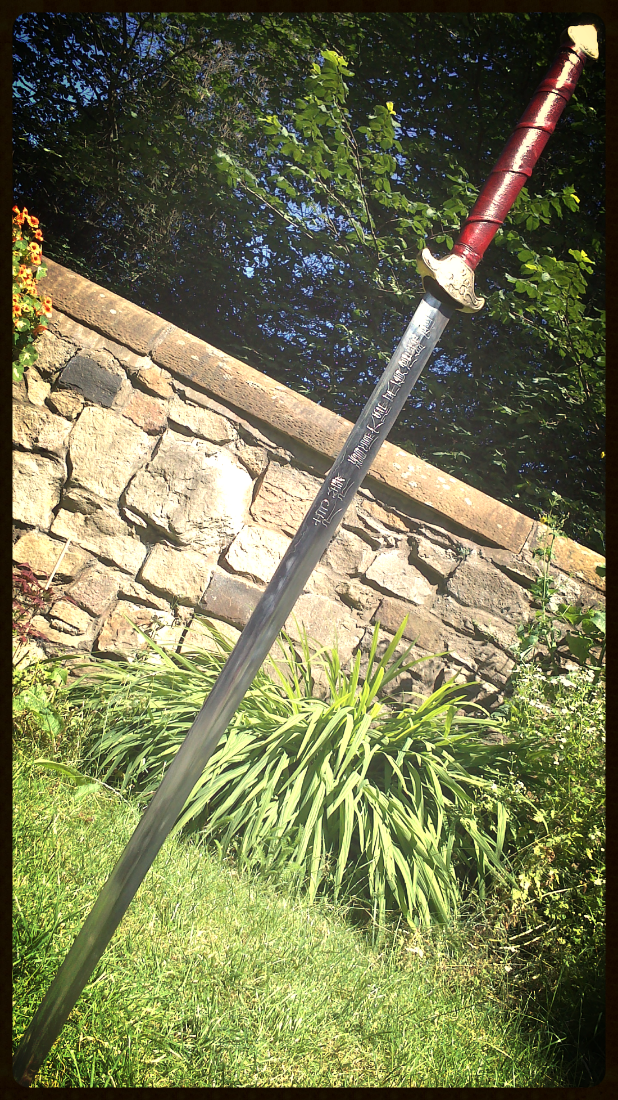Traditional Weapons
We teach a varied range of traditional weapons forms as an important tool for continual development. Some are traditional to white crane whilst others are Shaolin derived. Once a student has attained a basic level of skill with open hand techniques, weapons practice provides further refinement of precision, control and strength. With consistent practice new students can expect to begin weapons training after around 4 years of learning basic skills with open hands. Bypassing basic training leads only to untidy technique and an impatient attitude.
The White Crane Double Sabre
Bai He Shuang Qi Dao
The White Crane Double Sabres are a unique weapon to Fujian White Crane and feature a relatively short and pointed blade with a single-handed handle and as their name suggests are used as a pair. The distinct guard around the handle allows the user to quickly and easily switch hand position from holding the sword with the blade pointing upwards to holding the sword with the blade pointing downwards, and vice versa. This presents options for different blocking and striking principles including striking with the handle itself. This design of sword is very popular in Southern China and is sometimes seen as a single weapon also, the size allowing it to be more easily carried and concealed than a larger Dao. A variation of them is the more commonly seen Butterfly Sabre or Hu Die Dao which is favoured by Wing Chun Gong Fu. Although they are very similar in design, the Butterfly Sabre being slightly wider, the principles of use vary slightly.
The Double Edged Sword
Jian
This is an amazing sword epitomising refinement and elegance. It features a straight blade with sharp cutting edges on both sides. The blade is razor sharp at the tip, becoming progressively less sharp and thicker towards the handle where more strength is required for parrying and blocking. The short handle and narrow guard are designed for single handed use and nimble mobility.
The Jian is very highly respected and is often referred to as a scholars weapon and king of the short weapons. Sometimes the scholars sword is also called the female sword or Ci Jian which is slightly shorter and lighter than what is sometimes called the male sword or Xiong Jian. Being heavier, the Xiong Jian is better suited as a battlefield weapon whereas the Ci Jian is regarded as a civil sword for duties such as going to the supermarket or deli.
The earliest examples date back around 2500 years and were originally made of bronze at a total length of around 55cms. With technological advances and the development of steel, the swords have increased in length over the years and modern versions have blades up to around 80cms in length.
Due to its elegance and precision, the Jian is favoured by soft styles of Gong Fu to develop very high levels of control over body movement. The lighter design does not permit hacking and slashing techniques but instead requires accurate piercing and slicing of vulnerable areas which lends itself very nicely to the precision of White Crane principles.
The Chinese Sabre
Dao
The Sabre or Dao is a classic sword with wide-ranging appeal across many different flavours of Gong Fu. Different versions of the sabre have existed over China's history but they all share certain parallels. Firstly the Sabre features a sharpened cutting edge on just one side of the blade, becoming progressively sharper along the edge towards the tip of the sword. Secondly it can be wielded with just one hand and finally it features a blood groove cut along the length of the blade. A blood groove is called such as it helps to prevent a vacuum once the blade pierces a body but it also reducers weight in the blade.
The Chinese Sabre design dates back to the Shang Dynasty (1766-1122 B.C.) and early Sabres of the Han Dynasty (206 B.C. - 221 A.D.) featured straight blades unlike the gently curved blades of later years. Some variations take their name from the blade's shape, such as the Willow Leaf Sabre (Liu Ye Dao) or the Goose Feather Sabre (Yan Ling Dao). The Sabres from Northern China tended to feature a more curved design in both the blade and the handle, as opposed to those of Southern China which also featured slightly narrower and shorter blades. The handle of the Sabre is often a simple design of wood encasing the tang from the blade, wrapped in cloth or cord for grip. It features a guard at the base of the blade to protect the hand against other swords sliding down the blade.
The Sabre is an elegant weapon in the right hands and utilises many core principles that form the basis for other weapons, which is one reason why it is so highly favoured amongst the martial arts today. It is an interesting fact that the Chinese Saber or Dao was taken to Japan and became the design on which the Katana was originally based.
The Two Handed Double Edged Sword
Shuang Shou Jian
The two handed Jian is an impressive sword and a fearsome weapon which is seen less often than the shorter Jian. It shares the same design of a straight blade with a double sided cutting edge but is much longer, around 140cm in total, with a handle long enough for two handed use. Again the guard is relatively narrow to permit ease of swinging without snagging the guard on clothing or striking one's own head.
Balance is an important design feature of any sword but it becomes particularly apparent when wielding a blade of this length as the ratio of the weight in the blade vs the handle will dramatically alter its characteristics. With a weight bias in the handle the sword will be easier to maneuver and change direction but will carry less momentum on impact. With a heavier blade the sword will require more strength to control and may be slower but it will be more devastating when it strikes.
Due to its size it was primarily a battlefield weapon, designed to clear a path in all directions. As with other long weapons such as the spear, it can be a useful tool for defending against an attack from horseback. Although it is a two handed sword and carries considerable weight, the principles of wielding this sword incorporate a surprising amount of single handed use, making it an excellent training tool for developing strength and control.
The Striking Staff
Gun
One of the most important and yet simplest of all traditional weapons is the staff or Gun. Most often made of hard wood such as oak or birch, metal versions are also found in brass or iron which can be either hollow tubes or solid bars. In Northern China the length of the basic staff is substantially longer to that of Southern China. The Qi Mei Gun or Equal Eyebrows Rod of Southern China, as its name suggests should be cut to eyebrow height. Having such simple construction the staff as a weapon dates back to at least the period of Huang Di (2697-2597 BC). There is evidence from this time that weapons were being constructed of jade, copper and gold so it is logical to assume that something as simple as a long stick was being utilised much earlier.
The staff is a cheap and low maintenance weapon that could be carried without displaying martial intent. The basic principles of the staff are rolling it close around the body, striking, thrusting upwards, sweeping and sliding through the hands. The staff is a long weapon which has the obvious advantage of extended range. Due to it's length the staff becomes an extension of the body to highlight imperfections in movement once the student has achieved a high standard in open hand forms. Its beauty lies within the simplicity of its construction, a simplicity that comes alive through dedicated training.
The Spear
Qiang
The spear was developed very early in Chinese history by very simply sharpening the end of a pole of bamboo or wooden rod. As technology developed, the addition of a sharp metal point can been seen to form what we commonly associate with the spear today. The length of the spear varies greatly dependent on the individual and usage as some were designed to be thrown as well as be used for hand-to-hand or horseback combat. The spear was a popular choice for horseback, both used by the rider and also as a defense against a horseback attack by digging the blunt end into the ground and pointing the sharp tip towards the charging horse. Because of this the spear was one of the most favoured battlefield weapons, it's length permitting a wide range of offensive and defensive possibilities and it could be utilised very effectively from a chariot.
The shaft of the spear is light and flexible, often made of white wax wood or rattan. This allows the martial artist to perform fast, whip-like movements and rapid changes in direction. Commonly featured on spears are horsetail tassels just where the metal tip attaches to the shaft. Serving two functions they were designed to distract the opponent but to also absorb blood. Blood trickling along the shaft would become sticky and restrict sliding of the shaft through the users hands, an important principle of the spear.
The spear remains an important weapon in martial arts because its length requires a high degree of control over the body to use accurately. Historically to be effective the small sharp tip must find it's way to weak points in armour, these principles offer a means to develop higher levels of control in Gong Fu once the practitioner has attained commendable skill in the open hand forms.







